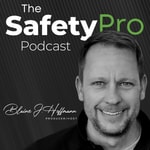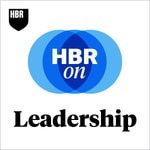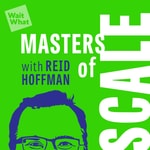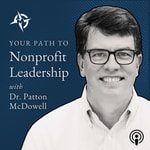The Safety Pro Podcast – Details, episodes & analysis
Podcast details
Technical and general information from the podcast's RSS feed.

The Safety Pro Podcast
Blaine J. Hoffmann, MS OHSM
Frequency: 1 episode/19d. Total Eps: 191

Recent rankings
Latest chart positions across Apple Podcasts and Spotify rankings.
Apple Podcasts
🇬🇧 Great Britain - careers
09/03/2025#80🇫🇷 France - careers
26/12/2024#80🇫🇷 France - careers
25/12/2024#56🇬🇧 Great Britain - careers
23/12/2024#100🇨🇦 Canada - careers
02/09/2024#100🇨🇦 Canada - careers
01/09/2024#68
Spotify
No recent rankings available
Shared links between episodes and podcasts
Links found in episode descriptions and other podcasts that share them.
See all- https://safetypropodcast.locals.com/
322 shares
- https://hbr.org/
311 shares
RSS feed quality and score
Technical evaluation of the podcast's RSS feed quality and structure.
See allScore global : 68%
Publication history
Monthly episode publishing history over the past years.
Episode 180: LIVE at the 2024 TapRooT® Global Summit - Rethinking SAFETY Communications
Episode 180
mercredi 21 août 2024 • Duration 52:03
Get the NEW Book "Rethinking SAFETY Communications"!
Join the Community of Safety Pros today!
Recorded live at the 2024 TapRoot Global Summit, join Blaine J. Hoffmann, MS OSHM as he talks with Mark Paradies and Alex Paradies from TapRooT® about managing your safety communications. Using Blaine's latest book, Rethinking SAFETY Communications, the panel talks about how developing a communications strategy, identifying communications channels, knowing your audience, and using storytelling can help improve human performance.
Check it out and join in on the conversation - become a SafetyPro Community member (FREE to join).
Premium Community members can access exclusive content like episode videos, video courses, templates/downloads, participate in live streams, and direct message/live chat with the Safety Pro.
Join the Community of Safety Pros today!
Visit Mighty Line Tape for all of your facility marking needs. Order your free sample of floor tape TODAY!
Visit Arrow Safety for all of your safety service needs. Remember to mention we sent you to get 25% off your estimate!
Episode 179: Real Talk about the EHS Profession w/Kyle Domin
Episode 179
lundi 17 juin 2024 • Duration 01:11:17
Join the Community of Safety Pros today!
In this episode, Blaine Hoffmann and Kyle Domin banter about the safety profession, the various job titles you see, confusing job descriptions, interviewing candidates, and even education programs for the safety profession. It's part career advice and part ranting!
Check it out and join in on the conversation - become a SafetyPro Community member (FREE to join).
Premium Community members can access exclusive content like episode videos, video courses, templates/downloads, participate in live streams, and direct message/live chat with the Safety Pro.
Join the Community of Safety Pros today!
Visit Mighty Line Tape for all of your facility marking needs. Order your free sample of floor tape TODAY!
Visit Arrow Safety for all of your safety service needs. Remember to mention we sent you to get 25% off your estimate!
170: Using a Cognitive Interview Technique for Safety Incidents
Episode 170
jeudi 6 juillet 2023 • Duration 25:37
Join the Community of Safety Pros today!
Join the Community of Safety Pros today!
Workplace incidents are never something that employers and employees look forward to experiencing. However, they do happen, and it's important for everyone involved to understand what happened and how it happened, which will require you to interview those involved in the incident.
So it stands to reason you will want to ask the right questions correctly to elicit the most accurate information possible. A cognitive interview technique is one of the most effective ways to do this. Read the full article here.
Please listen and share this episode with others. If you want to go more in-depth on this and other topics - become a SafetyPro Community member (FREE to join).
Premium Community members can access exclusive content like episode videos, video courses, templates/downloads, participate in live streams, and direct message/live chat with the Safety Pro.
Join the Community of Safety Pros today!
Visit Mighty Line Tape for all of your facility marking needs. Order your free sample of floor tape TODAY!
Visit Arrow Safety for all of your safety service needs. Remember to mention we sent you to get 25% off your estimate!
080: SMS Pt 1 - Safety Management System Defined
Episode 80
mardi 15 octobre 2019 • Duration 28:12
Powered by iReportSource
A safety management system (SMS) is a continuous improvement process that reduces hazards and prevents incidents. It protects the health and safety of your employees and should be integrated into everyday processes throughout the organization. Investing in an SMS makes a measurable impact on your bottom line and can be viewed as a competitive advantage.
The adoption of an SMS framework and thoughtful implementation of the various pieces can have a significant impact on protecting employees and enhancing your organization’s performance and profitability. Now, safety requirements may differ across industries; the best performing organizations focus on continuous improvement that achieves the ongoing reduction of risk with a goal of zero incidents. Yes, we do sometimes have to say that. And yes, just because you have zero incidents in a given reporting period does not mean the organization is risk-free. Like I always say, no injury doesn't indicate a lack of risk. But the best companies know this so they look at the individual components of the SMS that designed to achieve just that - lowered risk which nets us lower (or none) injuries — so focusing on the how gets us to the big aspirational goal.
Ok, so let’s talk about the recent history of SMS and how it may impact the general industry and eventually construction over the years. According to the FAA, SMS is the formal, top-down, organization-wide approach to managing safety risk and assuring the effectiveness of safety risk controls. It includes systematic procedures, practices, and policies for the management of safety risks.
Since requiring it in March 2015, the FAA says Safety Management System is becoming a standard throughout the aviation industry worldwide. It is recognized by the Joint Planning and Development Office (JPDO), International Civil Aviation Organization (ICAO), and Civil Aviation Authorities (CAA) and product/service providers as the next step in the evolution of safety in aviation. SMS is also becoming a standard for the management of safety beyond aviation. Similar management systems are used in the management of other critical areas such as quality, occupational safety, and health, security, environment, etc.
Safety Management Systems for product/service providers (certificate holders) and regulators will integrate modern safety risk management and safety assurance concepts into repeatable, proactive systems. SMSs emphasize safety management as a fundamental business process to be considered in the same manner as other aspects of business management.
By recognizing the organization's role in accident prevention, SMSs provide to both certificate holders and FAA:
- A structured means of safety risk management decision making
- A method of demonstrating safety management capability before system failures occur
- Increased confidence in risk controls though structured safety assurance processes
- An effective interface for knowledge sharing between regulator and certificate holder
- A safety promotion framework to support a sound safety culture
The Public Transportation Agency Safety Plan (PTASP) Final Rule in 2018 requires individual operators of public transportation systems that receive federal funds to develop safety plans that include the processes and procedures necessary for implementing SMS. Among other requirements, the rule calls on agencies to report their Safety Management Policy and processes for safety risk management, safety assurance, and safety promotion.
And as many safety pros know, ISO has developed a standard that will help organizations to improve employee safety, reduce workplace risks, and create better, safer working conditions, all over the world. Participants in the new ISO 45001 development process used other standards such as ANSI Z10 as well as British OHSAS 18001, Canada’s CSA Z1000, and the ILO’s OHSMS guidelines. There is even talk of OSHA’s VPP getting more aligned to the ISO 45001 Standard. So you can see a definite trend emerging when it comes to SMS.
So, in 2018, knowing ISO 45001 was coming, the National Safety Council (NSC) started investigating all the common SMS frameworks and identifying all of the things they had in common. They recognized many companies were getting bogged down with questions such as: What is a safety management system? How can it help me? Which framework is right for my business? How do I go about implementing an SMS? They knew the research supported the benefits of SMS implementation, but they wanted clarity on what that looked like and a simple way to illustrate what elements constitute a successful SMS.
So let’s break down what the core features or functions look like - an effective safety management system has the following features or functions:
- People – nothing gets implemented without people who are committed, engaged, and motivated; real safety change can’t happen without a competent, skilled workforce. You need the RIGHT people in the RIGHT position within the organization. It isn’t enough to have an incredibly motivated and engaged front-line if all or most of middle to upper management is not engaged or supportive. So you need to put the right people in the right places in the organization from top to bottom.
- Planning – thinking ahead is half the battle of implementation; planning for foreseeable risks and the administrative parts of a management system will produce smoother rollouts and better measurement of SMS success. You need to be able to break down the individual elements necessary, assess your current state, and measure any gaps. These gaps are the space in which you will work. You have to be good at evaluating current-state - I cannot stress that enough.
- Programs – most companies have EHS programs that identify and control most hazards, monitor and measure operational impacts to EHS performance, and eliminate deviations from the management system; individual programs must operate as part of the entire system, not independently. So think about machine safety; you will need a robust maintenance management program to fully achieve the level of machine safety required. This means measuring preventative maintenance work orders that are past due, identifying maintenance items that are not just critical to up-time, but also to safety, such as sensors, overflow preventers, valves that are identified as safety measures preventing disaster. So integrating safety with other areas of the business is critical.
- Progress – to avoid complacency, companies need to periodically measure compliance with regulatory and legal requirements, audit their SMS system, and review SMS performance with upper management. So you need to be able to break down all the pieces of the SMS into logical parts. Like Electrical, Confined Spaces, PPE, and even roles and responsibilities as well as frequent inspections required. I recommend identifying champions for each element and have them “own” that part of the audit. They need to objectively score the organization’s effectiveness of the execution of each element. Get folks from outside the safety function to drive buy-in and accountability and should be an annual thing, but you can break out each element and cover some monthly. Whatever works for your organization.
- Performance – measures of performance need to be set and include both lagging indicators and leading indicators and moving toward predictive measures; adopting these and evaluating safety metrics among the entire business performance landscape helps companies solidify safety on equal footing with other critical operational practices – adopting a mindset of “safe operations” versus viewing safety apart from operations. So instead of asking how safety performance is doing, measure overall business performance with safety as a part of the overall measurement score. So if production was up, but incidents were as well, then there should be an adjustment made to the productivity score as a result - make sense? Again, this gets us past the whole conversation of looking at WIP, deliveries, and sales together and safety separately - safety performance impacts the others.
The challenge for many safety pros is identifying the tools one can use to manage all of these moving parts. I will tell you that you need to look into a digital safety management system, like iReportSource.
Whatever you tool you use, you have to make sure you can efficiently stay on top of all of these different elements; be able to report, and have others report, the necessary information so the organization can work to reduce hazards; record and track all of the activities associated with those efforts - that make them work; have access to all of the data when needed to make smarter decisions; be able to look back so you can assess your progress objectively and plan for future improvements. I call these the 4 R’s:
- Report: Hazards, concerns, incidents, suggestions, etc.
- Record: Training/qualifications, observations, inspections/audits, injuries/illnesses, environmental data, etc.
- Retrieve: Be able to produce reports and records when needed promptly.
- Review: Have the ability to look at all relevant data, so it tells the story of where you have been, what is taking place, and where you need to go in real-time and as efficiently as possible.
It gets difficult to impossible to do this manually in most organizations of considerable size or with complex processes. So again, consider looking into a system to help you manage safety more efficiently and pays you back in time and frustration so you can get out from behind the desk and spend it where it matters most; out with your people where the work happens. Visit iReportSource for more information.
Once again, a safety management system is a continuous improvement process that reduces hazards and prevents incidents. It protects the health and safety of your employees and is integrated into everyday processes throughout the organization. Investing in an SMS makes a measurable impact on your bottom line and can be viewed as a competitive advantage.
Send emails to [email protected]. You can find me on LinkedIn! Post a LinkedIn update, letting me know what you think of the podcast. Be sure to @ mention Blaine J. Hoffmann or The SafetyPro Podcast LinkedIn page. You can also find the podcast on Facebook, Instagram, and Twitter
079: 4 Types of Root Cause Evidence According to TapRooT
Episode 79
vendredi 11 octobre 2019 • Duration 21:56
Powered by iReportSource
When an incident occurs it is the investigator’s main function to gather all relevant evidence in order to discover root causes and ultimately prevent a recurrence. The tricky part is that evidence isn’t always what it seems. Witnesses accounts can be spotty, inconsistent, they may tell conflicting stories about the same incident, etc. Physical or even environmental conditions can change before the investigation process begins. Paperwork, such as a work instruction or JSA, may be misplaced or even changed in some way. With all of these variables and more, you want to make sure you collect the right types of evidence during your investigation.
I want to share with you some information from TapRooT®, which is a systematic process and training for finding the real root causes and precursor incidents, for not only major accidents but minor mishaps and even near misses. According to TapRooT®, there are four types (or categories) of evidence to be evaluated. TapRooT® calls these categories 3 Ps and an R. This stands for:
- People evidence
- Paper evidence
- Physical evidence
- Recording evidence
People Evidence
Often, evidence collection starts with people evidence (a witness statement), and that evidence guides the investigator to collect paper, physical and recording evidence.
Examples of people evidence include:
- Interviews
- Fatigue-related information
- Evidence of injuries, including cuts and scrapes, bruises, fractures, or sprains
- Information about medical conditions that may have influenced performance (refer to HR or corporate counsel for guidance on HIPPA)
Where do you begin? First, determine who was involved. This includes those who planned the work, supervised the work and performed the work. Other considerations include a worker’s capability, capacity, training, and qualification to perform his or her role.
Inquire into the background of those involved. Determine if they have been involved in any previous incidents or if they have any related performance or conduct issues. Find out if those involved had any work restrictions such as an impairment, physical capability, or lapsed accreditation.
Understand how the employees worked together. What were the dynamics of the team including supervision and team performance? Determine the context (such as environmental conditions, distractions or perspectives).
Paper Evidence
Paper evidence may include all sorts of things including:
- Regulatory paperwork
- Activity-specific paperwork
- Personnel paperwork
- Policy and procedure paperwork
- Equipment manuals
What do you think the biggest mistake is when it comes to collecting paper evidence… given all of the paper that we have in our workplaces? Collecting too much paper not relevant to the investigation!
You don’t need to collect every piece of paper at your facility. How do you know what you don’t need? By looking at the timeline of events that led to the incident. You need all the paper that supports your timeline of events and supports the facts. If you use TapRooT®, you can easily upload digital copies of this paperwork, and highlight relevant pages in your report to management.
Don’t make the mistake of collecting so much paper that what you need for evidence is somewhere at the bottom of the stack.
Physical Evidence
Physical evidence can range from a very large piece of machinery to a very small tool. It includes hardware and solid material related to the incident. You will gather physical evidence in one of two ways. You will collect it or you will record/document evidence that can’t be collected (for example, it is too large to collect, or it is still in use).
Types of physical evidence to collect:
- Broken equipment/parts
- Residue/debris
- Fluid samples
- Paint samples
- Fiber
- Hair, bloodstains, tissue or other DNA
Types of physical evidence to record/document
Evidence is recorded when it is impossible to collect or when it is still in use by the workforce. Following is a list of possible evidence to collect by recordings:
- Burn marks and flame patterns
- Tracks
- Indentations
- Handprints, Footprints, Fingerprints
- Tools
- Equipment
- Products in use
- Equipment status (fixed, portable or temporary?)
- Lights, noise, and temperature
- Confined space
- Obstructions
- Surface hazards
- Housekeeping
- Clarity of signs and labels
- Instructions
Following are additional pieces of information you may want to collect:
- Failure history
- Modification/change of use
- Operator interface
- Maintenance records
- Installing/commissioning
- Storage/transportation
- Procurement
- Design/fabrication
Recording Evidence
Recording evidence, such as photography and video, should be captured as soon as possible after an incident to preserve the scene in images before it is altered in any way. It provides a documented overview of the entire scene. This may occur as soon as you or a qualified team member can obtain access to the scene.
In addition to video and photography recorded by the investigator, recordings include:
- Video footage (examples: site security cameras, control room cameras, traffic cameras, etc.)
- Audio recordings (examples: audio of the noise level, voicemail recordings, videos - check State Laws; many prohibit the recording of sound by security cameras in the workplace and there may be restrictions around recording conversations by phone or other devices as well, so always consult an attorney)
- Photos (examples: wide shots, up-close shots, any pics taken by others, security pics, etc.)
- Computer data (example: magnetic swipe card system security data for entry doors, data logs from machines/vehicles, inspections completed in the past, previous hazards reported, etc.)
- Sketches of an incident scene, such as with traffic accidents. Side note, iReportSource has a cool feature that allows you to create a road diagram with different streets, intersections, add multiple vehicles, lights, signs, etc. A pretty cool feature for capturing this stuff accurately without relying on your artistic skills (or lack of)
As you record the scene, ask “Am I recording the scene as it was in its original state or has it changed in any way?” If the scene has changed, make a note about what has changed including those involved and WHY! Be sure to capture that information. Identify fragile, perishable evidence and immediately document, photograph and collect it. Environmental conditions are a good example. Such as in the case of ice/snow and as the day progresses it melts, compounds, etc. Also, make a note of any transient evidence that can’t be captured by a camera or video like steam, smoke/vapors, smells, and temperature, etc.
Remember, the best way to collect unbiased evidence is to gather evidence from each of these four categories: people, physical, paper, and recordings. Each piece of evidence collected will help lead you to the root causes of the incident so that you can properly analyze them for effective corrective and preventative actions. Nothing is more frustrating than going through this process and determining what to fix only to learn that not only were you fixing the wrong things, but another incident has occurred that could have been prevented.
Let me know what you think. Send an email to [email protected] and share with me the tools and techniques you use!
If you think of it, find me on LinkedIn! Post a LinkedIn update letting me know what you think of the podcast. Be sure to @ mention Blaine J. Hoffmann or The SafetyPro Podcast LinkedIn page. You can also find the podcast on Facebook, Instagram, and Twitter!
078: How to Interview for a Safety Mindset
Episode 78
mardi 24 septembre 2019 • Duration 27:39
Powered by iReportSource
When a company is looking to hire its next safety leader they must be sure to select the right person for the job. But hiring a safety leader goes well beyond their safety and health credentials and experience. You want to have someone with the right safety mindset, not just safety background and experience. The same thing goes for hiring production or other team leaders.
Everyone knows the importance that teams play in organizational success. However, let’s not forget that teams are made up of individual players, each with strengths and weaknesses. In his book, The Ideal Team Player, Patrick Lencioni reveals the three indispensable virtues that make some people better team players than others, and this speaks to their mindset (1).
According to Lencioni:
Ideal team players are humble. This is a person who lacks excessive ego or concerns about status. Humble people are quick to point out the contributions of others. They are slow to seek attention for their own, explains Lencioni. They share credit, emphasize team over self, and define success collectively rather than individually. They also recognize and are well-aware of their own strengths, and they can easily share those strengths when asked (1).
Ideal team players are hungry. They are always looking for more. Hungry people rarely have to be pushed by a manager to work harder because they are self-motivated and diligent; at the same time, they aren’t so hungry that they are entirely consumed by work. They are continually thinking about the next step and the next opportunity. They have just the right amount of drive you want to see (1).
Ideal team players are smart. By “smart,” Lencioni means they have common sense about people - or high EQ (emotional quotient). You may have heard of this referred to as emotional intelligence or being highly self-aware. Smart team members tend to know what is happening in a group situation and how to deal with others in the most effective way. You may think of them as tactful or good at “dealing with people.” They have good judgment, a great perception of what’s happening a group, and can apply intuition well on teams (1).
So, how can organizational leaders interview for these virtues?
Ask the right open-ended questions designed to get them sharing their thoughts and beliefs. Sure, you need to find out a little more about their professional background as it pertains to the technical aspects of safety.
However, if the pre-screening process went as designed, hiring managers should only be interviewing technically qualified candidates at this point. So here is an opportunity to ask questions designed to determine if the candidate is going to be an asset to the team.
Here are some examples of the right questions and what they are designed to uncover:
1. How did you get into safety? Or whatever line of work they happen to fall into.
This question helps to uncover someone’s back story and helps someone to share what drives them and motivates them.
At this point, you can start to see if they are able to articulate the “why” about their career choice. This question can also encourage them to become more comfortable during the interview, too.
2. Has there ever been a situation or incident in your work that changed or shifted your approach to safety?
Are they able to learn from situations? How have they adapted in the past to improve their life and work for the better? This question, once again, starts to dig deeper and helps you know more about how humble someone is, and their degree of self-awareness, too.
3. What is something you would do to show senior leaders how safety can be a profit center?
This question helps to indicate more about their capacity for critical thinking. After all, you want a candidate to be able to make a connection between safety and other aspects of the business, and this can help you know more about how savvy they are in this arena.
4. What would you do if you saw a hazard or if you saw someone doing something unsafe at work? Has this ever happened—if so, how did you handle it? Was there anything you wish you could have done differently? (2)
The answer helps you know more about how a candidate chooses to approach others, especially when that situation is uncomfortable or can involve conflict.
5. How do you approach incident investigations?
Once again, this helps us to frame someone’s motivation and mindset and helps us know more about how they deal with others (smart), their ability to be forward-thinking (hungry), and their degree of self-awareness as it relates to their own ego (humble).
As you talk to the person, see: do they seek to put blame on people, or do they think in terms of fixing and improving processes? Do they start with “what someone did” or “what did we miss in this process”? Both responses are telling.
6. What are the most important accomplishments of your career?
This question, fundamentally, is another way of seeing what someone values. Look for more mentions of “we” rather than “I” to see how team-oriented they are. Of course, it isn’t about being so simplistic as to count the responses. In the event that someone refers to himself or herself individually more than as a member of a team, probe for whether he or she was working alone or with others.
7. What was the most embarrassing moment in your career? Or what was the biggest failure?
Look for whether the candidate celebrates that embarrassment or is mortified by it. Humble people generally aren’t afraid to tell their unflattering stories because they’re comfortable with being imperfect. And, they know their strengths and are confident in those strengths so failure isn’t seen as taking away from their self-worth, necessarily. Also, look for specifics and real references to the candidate’s own culpability.
Look for specifics about how the candidate accepted responsibility for that failure, what they learned from it, and if they actually acted on what was learned. The ideal time player isn’t arrogant when looking back, but they aren’t lacking confidence, either. They were motivated to grow and learn from the event, and are happy to share that fact, too.
8. How do you define success in safety? How would you measure it? (2)
This is another example of a critical thinking question. Can the candidate define what success looks like, how to tell, and more importantly, how to achieve that success?
9. What is the hardest you’ve ever worked on something in your life?
Look for specific examples of real, but joyful sacrifice. In other words, the candidate isn’t complaining but is grateful for the experience. Once again, this helps you to know more about what they really value, too.
10. Have you ever worked with a difficult colleague or boss? How did you handle the situation?
By asking the candidate about a difficult work relationship, you will learn if he or she can read situations and people and handle them skillfully.
This question gives you another chance to see if they have people smarts (not the same as intellectual smarts) and how much hunger they have. It’s one more chance to get insight into their overall ability to fit into your existing culture.
Let me know what you think - email me at [email protected]. Also, let’s connect on LinkedIn so we can continue to collaborate on workplace safety. You can post a comment on LinkedIn about this episode as well - be sure to @ mention Blaine J. Hoffmann or The SafetyPro Podcast LinkedIn page. You can also find the podcast on Facebook, Instagram, and Twitter!
Questions in this blog post were taken directly from Terra Carbert’s post, “Interview Questions for Safety” which can be found here and The Ideal Team Player interview guide by Patrick Lencioni.
Link to sources:
077: A Breakdown of Job Safety Analysis
Episode 77
jeudi 19 septembre 2019 • Duration 33:44
Powered by iReportSource
Get the JSA template HERE. OSHA has a great page for this topic HERE.
Many companies rely on a super-simple tool to define appropriate safe work practices for specific jobs. The Job Safety Analysis Process (also referred to as a JSA, or Job Hazard Analysis - JHA). The JSA is a very effective means of helping to identify and manage hazards associated with task thus reducing incidents, accidents, and injuries in the workplace. It is also an excellent tool to use during new employee orientations and operator training and can also be used to investigate "near misses" and accidents.
Job Safety Analysis (JSA) is based on the following ideas:
- That a specific job or work assignment can be separated into a series of relatively simple steps.
- Hazards associated with each step can be identified.
- Solutions can be developed to control each hazard.
To start the JSA Process, select the job or task to be performed. Any job that has hazards or potential hazards is a candidate for a JSA. An uncommon or seldom-performed job is also a candidate for a JSA.
Forms or worksheets (see sample worksheet) may vary from company to company but the idea remains the same. Identify all steps, hazards, and safe work procedures before starting the job. I have a template you can download to follow along. It is filled out with a hypothetical job. So grab that and follow along for more context. The JSA process is a multi-step process and goes something like this:
- Basic Job Steps: Break the job into a sequence of steps. Each of the steps should accompany some major task. That task will consist of a series of movements. Look at each series of movements within that basic task.
- Potential Hazards: To complete a JSA effectively, you must identify the hazards or potential hazards associated with each step. Every possible source of energy must be identified. It is very important to look at the entire environment to determine every conceivable hazard that might exist. Hazards contribute to accidents and injuries.
- Recommended Safe Job Procedures: Using the Sequence of Basic Job Steps and Potential Hazards, decide what actions are necessary to eliminate, control, or minimize hazards that could lead to accidents, injuries, damage to the environment, or possible occupational illness. Each safe job procedure or action must correspond to the job steps and identified hazards.
Through this process, you can determine the safest, most efficient way of performing a given job. Thus JSA systematically carries out the basic strategy of accident prevention: The recognition, evaluation, and control of hazards.
Now, how do we document this process and capture the results? It is prepared in a 3-column chart form, either portrait or landscape - I have seen both and listing the basic job steps on the left-hand column and the corresponding hazards in the middle column, with safe procedures for each step on the right-hand column. The right-hand column will essentially become your safe work instructions.
A completed JSA chart can then be used as a training guide for employees; it provides a logical introduction to the work, it’s associated hazards, and the proper and safe procedures to be followed.
For experienced workers, a JSA is reviewed periodically to maintain a safety-awareness on the job and to keep abreast of current safety procedures. The review is also useful for employees assigned to new or infrequent tasks.
Let’s talk about how to fill out the JSA. First, there is an art and science to breaking down a job or task into steps. If the steps are too detailed, the JSA will be complicated and difficult to follow. If they are not detailed enough, you may miss important steps and associated hazards. For example, let’s say you are planting a tree, and you need a JSA on how to unload the tree from the truck. You don’t want to say:
Step 1. Remove latch pin from the tailgate
Step 2. Release tailgate latch
Step 3. Lower tailgate to open position
Now you move to plant the tree, let’s say by hand:
Step 1: Retrieve shovel from the back of the truck
Step 2: Place shovel on the ground at the specified degree
Step 3: Place dominate foot onto the back of shovel at the mid-sole
This is tedious, no one will read that document. Instead, it may be enough to simply say, “open tailgate” as the job step and move to the second part of creating the SJA - listing all the hazards associated with that step. On the flip side, don’t over-simplify it either. For example, when planting the tree:
Step 1: Put tree in ground…that’s it. No step 2.
Ok, an extreme example of over-simplification. But be sure to walk through the job steps and look for opportunities to break it down into steps. If you already have job steps laid out, such as in the case of OEM operating instructions or manual this makes it a bit easier.
To make sure I illustrate this point, let’s talk about another example; let’s say you need to operate a 3D metal printer - you wouldn’t just state, “place build plate inside the print chamber, close door and start print operation.” There is obviously more to this process. This brings me to my next point; understand the difference between a job/task and a process.
A process is a series of physical, mechanical, or even chemical operations, often made up of several different jobs/tasks. On the other hand, a job/task is a single activity - either on its own or in support of a larger process, like 3D metal printing. In this example, there will be the storage, handling, and loading of metal powder. Then there is the build set up - like installing the build plate, and even post-printing work, like removing the printed part from the build plate, any grinding or buffing work on the part, hardening of parts in an oven, just to name a few.
Each job/task will have its own JSA form that, when combined will make up everything that goes into the overall process of 3D Printing. And the steps and hazards could be different for different types of print jobs - the print media could be different, the print machine models could be different, inserting gases, removal process, etc.
A good tip as you complete your JSA, make sure each job/task step starts with action - use verbs, like pull lever, push door, place ladder, etc. Steps that do not present a potential hazard should be left off. The exception would be if you intend to use this as a multi-purpose job aid covering other job steps (like for quality or production).
This layered approach may work well, as employees will see there is ONE way to perform the job. That brings up a great point, you may already have a work instruction that breaks down the steps. Maybe there is a machine operating manual. Be sure to review these with operators to ensure they are actually still relevant and cover all the steps they need to take.
Whether you have existing jobs needing to be reviewed or are implementing a new job or task, employee involvement is critical. So be sure to do a couple of walk-throughs of the process with operators before publishing the document. The JSA should be reviewed, approved, and signed by the supervisor before the task is started. Understanding every job step is very important! Whenever a job step changes or a new step is introduced, the JSA must be reviewed and updated.
Remember, the key reasons for completing a JSA are to encourage teamwork (especially with new employees), to involve everyone performing the job in the process, to increase awareness of potential hazards, and communicate safe operating procedures!
I have a JSA template download link in the show notes. Be sure to practice a few times and review it with others to make sure you get the hang of it. Make sure you do not overlook a job step/task that introduces a hazard! This is the whole point of this exercise - to identify and control hazards associated with performing a job.
Let me know what you think - email me at [email protected]. Also, let’s connect on LinkedIn so we can continue to collaborate on workplace safety. You can post a comment on LinkedIn about this episode as well - be sure to @ mention Blaine J. Hoffmann or The SafetyPro Podcast LinkedIn page. You can also find the podcast on Facebook, Instagram, and Twitter!
076: Leading Safety Excellence an Interview with J.A. Rodriguez, Jr.
Episode 76
vendredi 30 août 2019 • Duration 50:44
Powered by iReportSource
As I continue my podcast interviews in New Orleans from the 2019 VPPPA Safety+ Symposium I had the honor of interviewing some Association Board members. They shared some sound advice for anyone looking to improve their safety and health management system as well as some insights for safety pros struggling with challenges along the way.
Visit www.vpppa.org for more information about this amazing organization!
You can find me on LinkedIn! Post a LinkedIn update, letting me know what you think of the podcast. Be sure to @ mention Blaine J. Hoffmann or The SafetyPro Podcast LinkedIn page. You can also find the podcast on Facebook, Instagram, and Twitter.
#vpppa2019
075: Near Death Safety Lesson with Kelly Pitts
Episode 75
jeudi 29 août 2019 • Duration 09:42
Powered by iReportSource
Here at the 2019 VPPPA National Safety Symposium where everyone you meet has a story to tell. Kelly Pitts shares his message of a near-death experience and what you can learn and take back to your organization.
You can find me on LinkedIn! Post a LinkedIn update, letting me know what you think of the podcast. Be sure to @ mention Blaine J. Hoffmann or The SafetyPro Podcast LinkedIn page. You can also find the podcast on Facebook, Instagram, and Twitter.
#vpppa2019
074: PPE Safety for Women in the Workforce with Abby Ferri
Episode 74
jeudi 29 août 2019 • Duration 19:37
Powered by iReportSource
As I continue my podcasting interview marathon from the 2019 VPPPA National Safety Symposium, I had the absolute pleasure of sitting down with Abby Ferri to discuss the issues that women in the workforce continue to experience with PPE - which is in large part designed for men.
Abby has over 15 years of experience in the field of safety and health in diverse industries, including construction, manufacturing, healthcare, hospitality, beverage, and retail. Abby has become well-known in this industry as a practical and creative safety professional.
Learn more about Abby by visiting www.theferrigroup.co
You can find me on LinkedIn! Post a LinkedIn update, letting me know what you think of the podcast. Be sure to @ mention Blaine J. Hoffmann or The SafetyPro Podcast LinkedIn page. You can also find the podcast on Facebook, Instagram, and Twitter.
#vpppa2019









